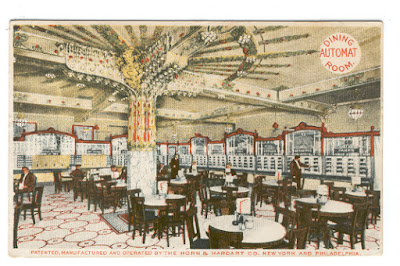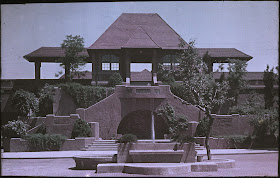By Michael Perlman
 |
| The eagle-adorned Forest Hills Stadium, Photo by Michael Perlman |
 |
| Grand Slam Automat preliminary rendering, Courtesy of Madison House Presents & Creative Director Bill Sullivan - Note: Current text is only for theme |
 |
| Winter Wonderland ice skating daytime rendering, Courtesy of Madison House Presents & Creative Director Bill Sullivan |
Also part of the vision is to offer ice skating on its hallowed courts, in addition to a Christmas tree with holiday vendors as part of a "winter wonderland” carnival. “We have been dreaming about this general idea for years, and now there are a number of options that we are working on,” said Concert Manager Mike Luba of Madison House Presents, who works closely with Jason Brandt, the stadium’s general manager. “When the concepts are more fully developed, we will present the ideas to the board of the West Side Tennis Club (WSTC), and they will let us know if we have the approval to move forward,” said Luba.
 |
| Winter Wonderland ice skating rendering, Courtesy of Madison House Presents & Creative Director Bill Sullivan |
Since a proposal has yet to be submitted, there are hopes that the vision will materialize in time for next winter. He continued, “As the WSTC has been a great partner on the stadium restoration/renovation, I am hopeful that they will continue to be supportive of ideas which are not only good for the WSTC, but for the neighborhood and Queens.”
Madison House Presents continues to keep the community and visitors on its radar, and expressed much sentiment for a historic stadium. “The stadium and its grounds are magic, pure and simple, and we are always dreaming of events that will hopefully boost the quality of life for those who get to experience them,” said Luba.
 |
| Winter Wonderland carnival rendering, Courtesy of Madison House Presents & Creative Director Bill Sullivan |
Forest Hills was once home to smaller scale Horn & Hardart Retail Shops near the stadium at 71-63 Austin Street and 116-63 Queens Boulevard, and the firm’s vice president, Frank Hardart, Jr, resided at 188 Ascan Avenue and 64 Dartmouth Street in Forest Hills Gardens. Marianne Hardart, the great-granddaughter of H&H Automat co-founder Frank Hardart, keeps the Automat’s history alive and emphasized much pride. “People always ask me about bringing back the Automat, as it held a special place in their heart and our country’s history, and it sounds like Forest Hills Stadium’s installation of Automat windows would be a beautiful tribute.”
 |
| Horn & Hardart Retail Shop, 71-63 Austin St, Forest Hills, Courtesy of John W. Romas Collection |
 |
| Courtesy of Michael Perlman & Rego-Forest Preservation Council |
 |
| Horn & Hardart Automat at 1557 Broadway, 1st branch in NYC which opened in 1912 - Now Grand Slam, Courtesy of Michael Perlman & Rego-Forest Preservation Council |
Marianne Hardart also explained how the H&H Automat was a forerunner from its architecture to affordability of delicious fresh food. “Those little windows sparked the imagination of diners of all ages and introduced a new way of generations of Americans by getting a handful of nickels from a thrower and then going to the windows to pick your food. It was an adventure especially for children, and was also a place that tore down barriers based on class, gender, or race, as it welcomed everyone.”
 |
| Forest Hills Stadium Creative Director Bill Sullivan poses with his book, "Forest Hills" in front of the WSTC Clubhouse, Photo by Michael Perlman, August 2018 |
Bill Sullivan is an artist who serves as Forest Hills Stadium Creative Director. He has designed logos, media material, and most recognizably, colorful portrait heads and plaques celebrating the stadium’s role in tennis and music that can be found along the stadium arcade’s colonnade. In commemoration of the WSTC’s 125th anniversary in 2017, he produced banners which bear homage to historic achievements. He even authored the book “Forest Hills,” which features a large collection of his re-imagined photos that capture the evolution of tennis viewed through its players and its impact on architecture, art, and fashion.
 |
| Architect Kenneth MacKenzie Murchison, the famed public buildings architect who designed Forest Hills Stadium, Courtesy of Murchison's descendants |
Sullivan praised Stadium architect and past WSTC member Kenneth Murchison as a Renaissance man. “Murchison had a theatrical vision with a pageantry to celebrate the tennis match, and created a planned experience. Every year it changed into a slightly new form, and my book is about the element of change within the stadium’s horseshoe.”
 |
| One of the well-known Art Deco locations on 6th Ave & W 57th St in the 1930s - Now demolished, Postcard courtesy of Michael Perlman & Rego-Forest Preservation Council |
Sullivan patronized one of the last Automats on West 57th Street. Looking forward, he said, “We are trying to integrate the quality and streamlined aesthetics of a very American experience, and offering a new way to serve around 10,000 people.” Concertgoers could “pick, swipe, and take” hot and cold sandwiches from the Grand Slam Automat’s compartments. The Tilden, named after tennis player Bill Tilden, could offer a Philly cheesesteak, and The Connolly, as in tennis player “Little Mo” Maureen Connolly, could serve grilled chicken. “It would have clocks with four time zones for the Grand Slam; Australian Open, French Open, Wimbledon, US Open,” said Sullivan.
The vision does not end there. “A new scoreboard would celebrate tennis and music’s past,” said Sullivan. Some upcoming concerts include Robert Plant & The Sensational Space Shifters on June 13, Roger Daltrey performs The Who’s “Tommy” with The New York Pops on June 17, Boy George & Culture Club on July 28, and David Byrne on September 15. The expansive lineup continues with the first-ever food festival, “The Infatuation’s EEEEEATSCON” on October 6, and New York radio station WFUV creating an on-site experience within a dedicated space, the “FUV Clubhouse,” to broadcast select shows live on air. The complete lineup which includes comedy is at www.foresthillsstadium.com At the public’s request, plans continue with new gender-inclusive permanent restrooms on its main concourse, which will minimize wait time for a more enjoyable concert experience.
Sullivan called Jason Brandt a chess master of today’s space, and explained, “Jason often talks about ‘creating discoverable experiences,’ and we always want people to think there’s something new and interesting around the corner in Forest Hills. We are the caretakers of this cathedral of American tennis and music, which is unlike any place in the world, but there was a lost past at Forest Hills Stadium. Now people are rediscovering how the stadium and its grounds were built.”
Dadras Architects, a firm led by partners Robert Dadras and Victor Dadras, who founded the Downtown Revitalization Group, which specializes in historic preservation, urban design, and adaptive reuse, is well-acquainted with Forest Hills, and also expressed much enthusiasm for the stadium’s future. “The idea of bringing back an Automat is innovative, and I also suggest events for the diverse audiences that live in Forest Hills would be very much appreciated,” said Robert Dadras. He referenced the stadium and Forest Hills as superb examples of urban planning and architecture accomplished correctly. “Anything that can help preserve and restore Kenneth Murchison’s iconic structure would be a positive thing, since it stands as a rare example in today’s world of what can be achieved if folks collaborate to produce a quality place to live, work, and play.”
 |
| Forest Hills Tennis Stadium as America's Tennis Stadium in Ad, The Technology Review November 1922, Courtesy of Michael Perlman |
A similar version appears in Michael Perlman's Forest Hills Times column: www.foresthillstimes.com/view/full_story/27564281/article-The-Continued-Evolution-of-Forest-Hills-Stadium










